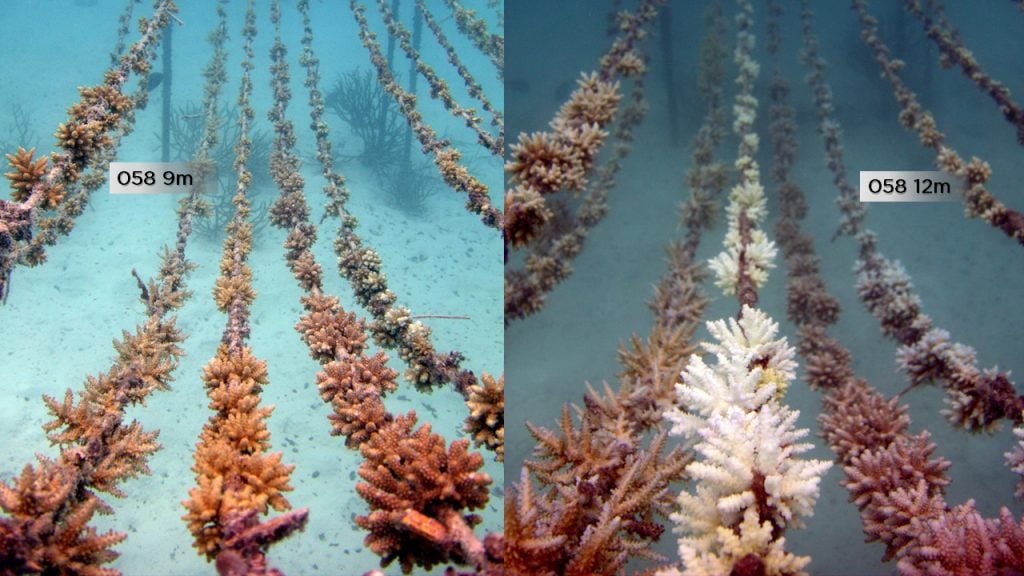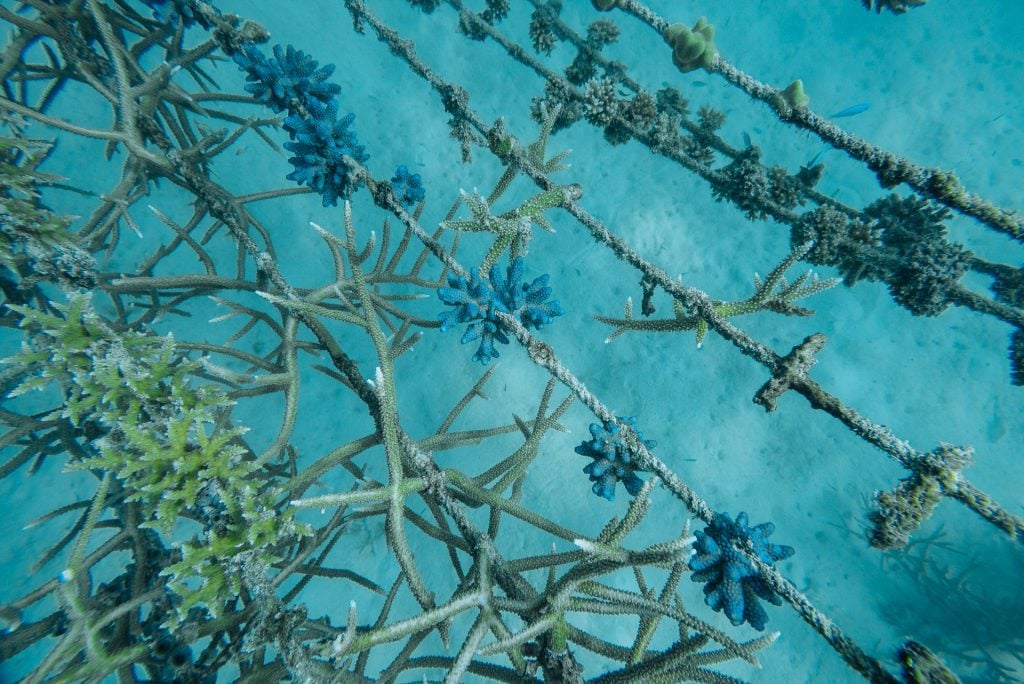Following the mass bleaching event of 2016, it is important to understand what coral bleaching is, and what the consequences are for the reef, as well as for our nursery. This page is not only a explanation of bleaching, but will also document the mortality in our nursery caused by the bleaching as soon as we have the data analysed. Stay tuned for more info on species survival.
What is Coral Bleaching?
In April 2016, we started to notice the usual colours draining from our beautiful corals. This phenomenon is known as Coral Bleaching, and is caused by excessive stressful conditions in the seawater. To understand coral bleaching and why it is happening it is useful to first understand what coral really is…
Coral is made up of hundreds of tiny jelly-like creatures, all attached to each other. Like their jellyfish cousin, these animals have stinging tentacles that are used to catch plankton in the water for food. The animal’s skin is actually transparent, but living within it are thousands of plant or algal cells called zooxanthellae, which give the coral polyps their colours (browns, greens and yellows). The algal cells provide the coral animals with lots of energy. In fact, about 90% of the energy that coral needs to survive is taken from these algal cells as they convert sunlight into sugars through photosynthesis. With this energy, the coral animals are able to build a hard, limestone skeleton by accumulating naturally occurring calcium and carbonate ions from the seawater. This skeleton is white, and this is what we see during coral bleaching events (explained later).
Coral bleaching is a stress response to unfavourable abiotic or biotic conditions. The 2016 bleaching event happened because of an increase in water temperature. We experienced very hot and calm weather during April and May 2016 in Maldives. This was caused by El Nino– a cyclic weather phenomenon affecting the Pacific Ocean which is so influential that the whole world can feel the effects. Here in the Indian Ocean, we experience a rise in sea surface temperature. Since 1900, the world has endured 26 El Nino events, and the 2016 El Nino was, in some aspects, the strongest in recorded history with sea surface temperatures rivaling that of the 1997/1998 El Nino, with an average increase of 2.3°C!
These unusually high water temperatures are damaging the delicate relationship between the coral animal and algae, which live together symbiotically. The animal respires by taking in oxygen and releasing carbon dioxide as a waste product (just like humans), whereas the algae respires in the opposite fashion; by taking that carbon dioxide ‘waste’ and releasing oxygen. Thereby, the coral and algae use each other’s waste and live in a perfect balance. When the temperature increases, the algae start to release oxygen radicals, or bad oxygen molecules, which can damage animal tissues. Because of this, the animal must expel what has become harmful algae. As the algal cells are ejected, the coral loses its colour, as now only the transparent tissue and the white skeleton beneath are visible. This coral is not dead, rather it is surviving in a stressed state, where it must try to gain all of its energy by capturing plankton. In this bleached state, without those energy making algal cells, coral can only survive for about 3 weeks, by which time the coral starts to metabolise its own tissues and, in effect, it starves. Other factors affect the survival of bleached corals, particularly the amount of harmful UV from the sun that the coral is subjected to. The algal cells usually absorb this, but without them, the corals delicate skin can become burned, which is possibly the reason for those fluorescent pigments – a natural sunscreen. If the normal temperatures return, the corals can capture new algal cells for storage, recovering its colour again and its vitality.
In 1998, the El Nino event was responsible for the loss of an estimated 80% of the coral in the Maldives! This current event is expected to have been worse, but scientists are still collating the data from around the country. As corals grow quite slowly, it could take between 10-15 years for many reefs to make any decent kind of recovery. El Nino events are increasing in severity and frequency- this is a direct cause of anthropogenic Climate Change. If the Maldives loses its reefs, it will lose its fisheries, its tourism and eventually its islands. These reefs are intrinsically linked to Maldivian survival- don’t sit by and watch. Do your bit to help the planet. it is so important for us to try and reduce our carbon footprint, both as individuals and within our businesses! Help the planet and our coral reefs (and also your wallet) by saving energy, streaming for renewables, and reducing emissions!

So What Does the Coral Bleaching Mean for our Coral Lines?
We have kept a close eye on our coral lines during this period and our monitoring has found that although some lines have proven susceptible to the thermal stress and are paling in colour (Acropora pulchra and Acropora cytherea), other lines have not been affected at all and are still thriving (Pocillopora damicornis and Porites cylindrica). Each line in our nursery is made up of 50 corals of the same species and genet (colony). Any differences we see in bleaching susceptibility within and between lines shows us how resilient each different coral species can be and how replicates of the same genetics react in such conditions. Due to our unique nursery set-up, we are able to investigate similarities and differences between species, within species, and even within genotypes. These investigations can help us gain an idea of which species are likely to persist on future, potentially warmer reefs, and will help us to select resistant genotypes for further fragging, enabling us to grow a nursery of bleaching resistant colonies.
Overall, the coral lines appeared to show less bleaching than the corals on our house reef and the shallow reefs around this atoll. Almost all lines are showed signs of bleaching, however, only a few lines in the nursery fully bleached. The reason for this relatively positive outcome is that the lines are down at 5m depth, just below the thermocline, which is keeping our corals a little bit cooler. Whilst we experienced 34°C (!) on the surface waters, water temperature is about 2°C cooler at 5m. However, this was still unusually warm. For example, in May 2016 we recorded highs of 31.9°C, compared with 30.3°C from last year! This is 1.5°C warmer than last year! Below you can see the average temperature recorded on our house reef data logger which is based at the same depth as the coral lines. The data here is taken from August 2015 to May 2016 – note the rise in temperature since April 2016!
For those lines which were due to have been transplanted on the reef by now, we decided a few months ago to hold them in the nursery for an extended period in order to wait out the bleaching event. By not moving them, we minimised the likelihood that they would become stressed and bleached following transplantation. This proved to be a good move, as we lost all Acropora species on our house reef, where many of our nursery Acropora survived.
During the warming period, which lasted until last June, we still accepted donations, but did not put any new lines into the nursery. The coral planting method itself will induce a certain degree of stress as we fragment colonies, which will leave the new lines more vulnerable to the bleaching than our older lines. Smaller coral fragments fared significantly worse than the bigger ones in the nursery, where newer lines suffered more mortality than older ones. Once the temperatures had returned to normal, in July, we resumed the project in terms of planting new lines. Transplanting older ones to the reef will commence in August.

Unfortunately, there is not much we could do for our nursery other than moving the lines into slightly deeper water and providing some shade from the sun. Since the event we have started to see some promising recovery as bleached lines regain their darker colours, where many species now locally extinct on our reef have survived in our nursery! These will be used to kick start recovery and re seed the damaged areas. We must be careful when transplanting though, as all the coral predators (Crown of Thorns starfish, and Drupella snails) have now concentrated on whatever live coral remains – we need to ensure those predator numbers are controlled before transplantation. In the meantime we will continue to monitor the lines and document what we are seeing.